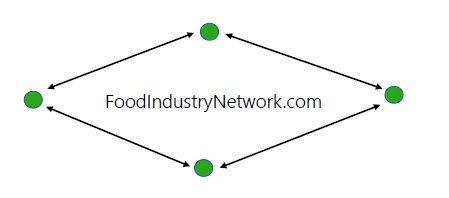Fueling the food industry’s climate agenda with transparency and collective action

Eight months on from COP 26, there’s been an increase in company net-zero commitments¹. So, as attention turns to this year’s climate summit, where new steps to meet emissions targets will be announced, what do we need to do to ensure the food industry is playing its part?
For food and beverage companies, measuring and reporting on emissions targets is particularly complex due to the bulk of a product’s carbon footprint lying beyond the factory gates, in the supply chain. This makes calculating the impact of the different ingredients that go into say, a carton of chocolate almond milk, challenging. And traceability becomes even more blurred when ingredients like cocoa, coffee or cashew are predominantly sourced from smallholder farmers in remote areas that can go through several intermediaries before reaching your door. But it is these Scope 3 emissions that are key to hitting meaningful reduction targets and accelerating the food industry’s journey towards net-zero.
Since 2019, ofi has launched its first public climate targets across various supply chains including cocoa, coffee, cashew, hazelnuts – and now almonds. These include a 50% reduction in GHG emissions in the cashew supply chain by 2030, 50% reduction of untreated coffee wastewater, and 30% reduction in natural capital costs for cocoa. Together, these targets build on over a decade of sustainability experience carried over from our Olam heritage, introducing a more transparent and structured approach, supported by our purpose to ‘Be the change for good food and a healthy future’. This however, requires greater transparency across the supply chain and collective action to deliver sustainability impact at scale.
Vast amounts of data are needed to offer this transparency and support ESG reporting. Knowing where carbon emissions are coming from in your supply chain is critical to understanding how to reduce them and deliver the most impact. Companies purchasing ofi’s cocoa, coffee, nuts and spices ingredients, have the benefit of the tools and data available on AtSource, the sustainability insights platform, to understand and report on their environmental (as well as social and economic) impact. Collected by enumerators across our sourcing networks, the data covers farm to factory, including the emissions linked to land-use change, fertilizer and pesticide use, irrigation, and for some products, the amount of carbon sequestered in soil and trees. The different levels of data cater for different sustainability management requirements, all of which help customers understand their carbon footprint and for us, identify where we can make the most impact according to the carbon reduction pathways we have developed.
So for US coffee roasters, we can calculate the overall GHG emissions for specific blends of coffee. Take a Brazil natural arabica, Honduras washed arabica and Indian robusta blend – they can see the carbon emissions from each of our three AtSource+ supply chains, from the farm, through processing, and transport. And that reducing fertilizer-use and improving residue management are the main contributors to the reductions we’re seeing so far. Turning to our own farming operations, we know that irrigation still contributes over 40% of our on-farm footprint for almonds grown on our California orchards. Dry wells and recharge ponds are capturing 13 trillion gallons of water runoff every year across our US and Australia orchards, and we’re building on current efforts around groundwater conservation and smart-irrigation techniques with dedicated 2030 water targets, to be announced next month.
Armed with this insight, customers can assess the progress of their sustainability ambitions, and have the opportunity to work with us on targeted interventions to advance them. Indeed, multi-stakeholder solutions are key to untangling the socio-economic factors that environmental challenges are often rooted in. Working with partners like the California Water Action Collaborative (CWAC) for example, can offer supportive frameworks for water stewardship. Accessing their insight into the workings of the regulatory and natural environment allows us to more clearly determine how our water usage affects the communities and ecosystems around us. Or in Mexico, where our partnership with Rainforest Alliance and USAID is piloting the LandScale approach to assess and evidence sustainability impact on the entire landscape of Chiapas – one of the country’s key coffee growing regions.
Delivering change at the speed and scale required can only be achieved if we look beyond our supply chains to the wider landscapes and actors within it. With unyielding demand for greater transparency and action, from NGOs to consumers alike, we need to embrace shared responsibility for solving the sector’s intractable challenges and create real impact for people and planet.
ofi publishes the first public sustainability strategy for its 50,000 acres of almond farming operations this month, followed by impact reports for its cocoa and coffee supply chains.
¹ https://www.ceres.org/news-center/press-releases/climate-action-100-net-zero-company-benchmark-shows-increase-company-net
Source: fooddive.com

